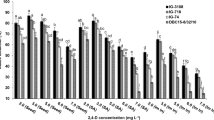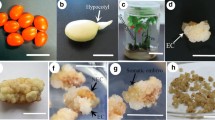Abstract
A white, compact embryogenic tissue was obtained from young inflorescence segments ofEchinochloa crusgalli (barnyard grass) cultured on Murashige and Skoog's medium containing various concentrations and combinations of 2,4-dichlorophenoxyacetic acid and 6-benzylaminopurine. Histological and scanning electron microscopic studies revealed that the white compact callus contained embryoids in various stages of development. Typical embryoids were bipolar and possessed scutella, coleoptiles and coleorhizae. The embryogenic nature of the callus was maintained throughout eight to ten subcultures spanning more than six months. A high frequency of plant regeneration was obtained when the 2,4-D concentration was reduced or 2,4-D was removed from the medium.
Similar content being viewed by others
Abbreviations
- BA:
-
6-Benzylaminopurine
- CH:
-
Casein Hydrolysate
- 2, 4-D=2:
-
4-Dichlorophenoxyacetic acid
- MS:
-
Murashige and Skoog's Medium
- NAA:
-
Naphthaleneacetic acid
References
Botti, C. and I.K. Vasil. (1984). The ontogeny of somatic embryos ofPennistum americanum (L.) K. Schum. II. In cultured immature inflorescences. Canad. J. Bot. In Press.
Cocking, E. C. (1978). Protoplast culture and somatic hybridization. In: Proceedings of Symposium on Plant Tissue Culture, pp. 255–263 Scince Press, Peking.
Ho, W. and I.K. Vasil. (1983). Somatic embryogenesis in sugarcane (Saccharum officinarum L.) I. The morphology and physiology of callus formation and ontogeny of somatic embryos. Protoplasma 118:169–180.
Murashige, T. and F. Skoog. (1962). A revised medium for rapid growth and bioassays with tobacco tissue cultures. Physiol. Pl. 15, 473–497
Ozias-Akins, P. and I.K. Vasil. (1982) Plant regeneration from cultured immature embryos and inflorescences ofTriticum aestivum L. (wheat): evidence for somatic embryogenesis. Protoplasma 110:95–105
Vasil, I.K. (1982). Somatic embryogenesis and plant regeneration in cereals and grasses. In: Plant Tissue Culture 1982, ed. A. Fujiwara, pp. 101–104. Maruzen, Tokyo.
Vasil, V. and I.K. Vasil. 1982a. Characterization of an embryogenic cell suspension culture dervied from inflorescences ofPennisetum americanum (pearl millet, Gramineae). Amer. J. Bot. 69: 1441–1449.
Vasil, V. and I. K. Vasil. (1982b). The ontogeny of somatic embryos ofPennisetum americanum (L.) K. Schum. I. In cultured immature embryos. Bot. Gas. 143: 454–465.
Vasil, I.K. (1983) Regeneration of plants from single cells of cereals and grasses. In: Genetic Engineering of Eukaryotes. eds. P. Lurquin and A. Kleinhofs, pp. 233–252. Plenum, New York.
Wang, D. and I. K. Vasil. (1982). Somatic embryogenesis and plant regeneration from infloresence segments ofPennisetum purpureum Schum. (Napier or Elephant grass). Pl. Sci. Let. 25:147–154.
Author information
Authors and Affiliations
Additional information
Communicated by I.K. Vasil
Rights and permissions
About this article
Cite this article
Wang, Dy., Yan, K. Somatic embryogenesis inEchinochloa crusgalli . Plant Cell Reports 3, 88–90 (1984). https://doi.org/10.1007/BF02441006
Received:
Revised:
Issue Date:
DOI: https://doi.org/10.1007/BF02441006




